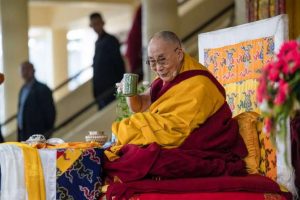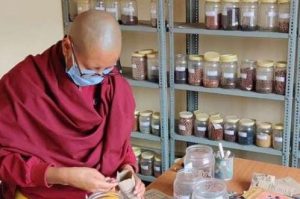
Do you notice an increasing number of “pilgrimage trips” advertised via e-mail, on websites, in print journals, at Dharma centers, and more that highlight different exotic locations in the world of Buddhism? What do you consider: will it be a religious trip, a chance to follow a master teacher, an academic journey, a retreat of sorts, or perhaps a sightseeing tour? And who leads, who organizes, and who goes along? What do you hope to share and discover while making such a trip? This journey will take energy, money, and time out from one’s normal life to pursue. We also haven’t even begun to consider how your intellectual and spiritual processes might change, too.
“Why do people make pilgrimage trips?”
Buddhistdoor Global’s team recently surveyed some travelers to Myanmar on their motives for Buddhist pilgrimages. Here, we’ve compiled their points on what they felt about making pilgrimage trips. Whether you travel in a group or on your own, what you carry away afterwards will be something quite personal in its meaning and significance.
The Myanmar group visited holy sites, meditation centers, monasteries, community projects, and did general sightseeing in four different cities. Members included mostly lay professionals and three monks—two of the Theravada tradition, and one of the Mahayana.

To learn more about Buddhism: The first survey answer shows that people seek more understanding about the world of Buddhism, both in their minds and hearts. This great religious family seems complex, confusing, and full of contrasts between traditions, rituals, and cultural variations. Are the teachings different too? Travelers want to discover more about the religion and how differences evolved throughout history and geographic changes.
To share discussion with others about Buddhism: The second survey response indicated that people desire to travel and communicate with others about Buddhism as the central theme. Whether speaking about the Dharma, asking questions, exchanging spiritual tales, or opinions about life—there is comfort to be found in a like-minded community. The non-Buddhist members in the survey enjoyed the opportunity to learn more about Buddhism in an open manner that was accepting of religious differences. The Buddha himself stated that all are welcome to inquire for themselves.
Fellowship of group travel and monks: Traveling in a group led by monks is highly beneficial, so much so that it is the third reason why people in our surveyed group want to go on pilgrimage. They are “living examples” of the teachings in their codes of behavior and openness to explain, encourage, and inject humor during challenging moments. It creates the feeling of a sangha for pilgrims in the shared harmony, exchanges of gratitude and inquiry, and sense of purpose in the trip.
For meditation practice: The fourth most popular reason is for pilgrims to leave their busy lives back home. Trips are an opportunity to learn or practice meditation. The choices are diverse. One can practice walking meditation while circumambulating holy monuments, chant sutras for blessings, listen to Dharma talks for spiritual nourishment, or practice Vipassana for observing mental states. The ambience of each location and variety of meditation methods can lead to new insights.
Buddhism as a living tradition: Traveling to a country where Buddhism is the predominant religion is different from simply reading about it. We can witness and absorb the local respect for centuries-old traditions that underlie their daily lives. We can learn about differences in culture, rituals, teachings, education, and economy between monastic and lay communities. Relationships are defined by history, cultural influence, devotional practices, and belief systems that date back to ancient times.
In Myanmar, home to the Theravada tradition, the obvious symbiotic relationship between monastic and lay communities is the dana offerings provided each day for sustenance. Other poignant displays of respect towards monastic members can be seen in the bows, smiles, prostrations, and touching palms in reverence of the robes as a symbol of the Triple Gem.
To experience different cultures: Making pilgrimage trips take us out of our comfort zone and into a heightened awareness of cultures, lifestyles, economics, and protocol that can be very different from our own. Local guides can illuminate the daily habits of ordinary citizens, and facilitate dialogue for exchanging stories with visitors. Locals, too, are often eager to know what brings the pilgrim to their country.

The “niceness” factor: One popular tour guide (on a different pilgrimage trip in India last year) summed up his favorite reasons for leading Buddhist pilgrim travelers more than any other kind of travel group: “Because they are so nice! Nicely behaved, nice and polite with each other, genuinely interested in the trip, and grateful for all the effort made on their behalf.” Surveyed travelers agreed that fellow pilgrims are friendly, and tolerant, and overall a relaxing break from the demands of regular life back home.
Sound sappy and unrealistic in today’s world of cranky misadventures? Try it out; take a pilgrimage trip in a Buddhist context. There may be insights to learn other than a bit of history, cultural sightings, and a group adventure. It is a definite plus if venerable monks and/or nuns come along to impart more wisdom of the Buddha’s teachings. One week of “niceness” can offer gentle reminders for compassionate practice upon returning home to normal daily routines.
Precautionary measures: it is only fair to temper the positive survey answers with a few sensible realities. Travel to countries with sometimes unfamiliar conditions: weather, insects, hygiene, water and food supplies, medical facilities, safety standards, living conditions, etc. can be an interesting challenge. Do your homework on the basic facts and prepare your mind and body for some trials along the way. After all, that is part of the pilgrimage journey too. How do we cope and mentally process what happens around us and to us? By taking this kind of special trip, an appreciation of the Buddha’s teachings can be cultivated for both intellectual and spiritual growth.
Open the heart,
Observe your thoughts,
Mindful attention to experience the journey,
Enjoy the discovery while on a Buddhist pilgrimage.







